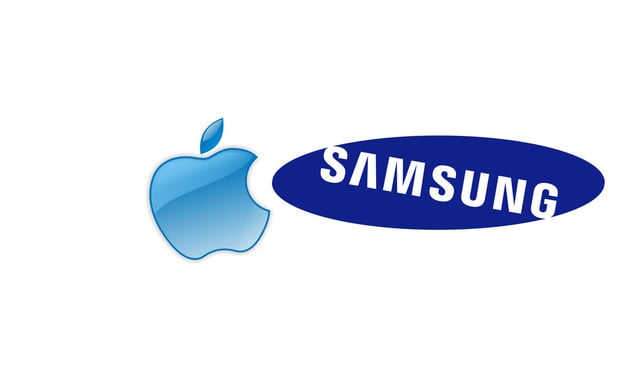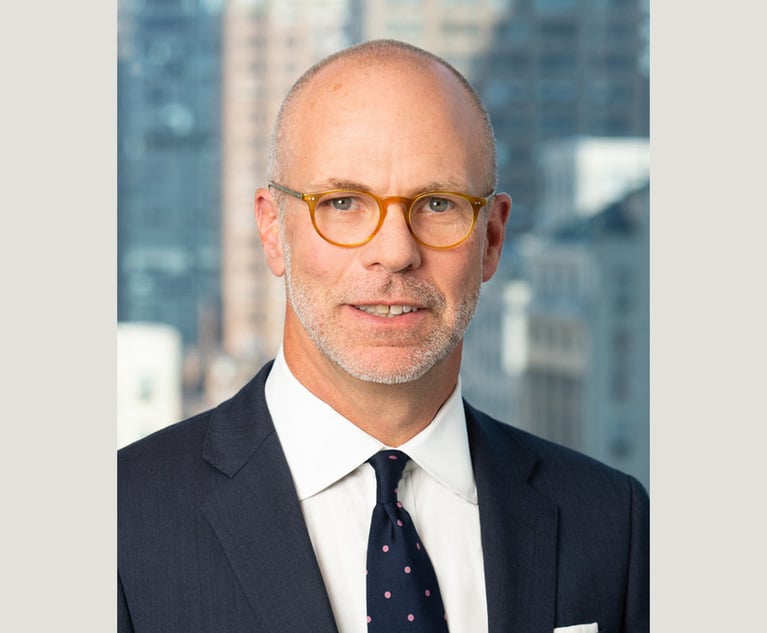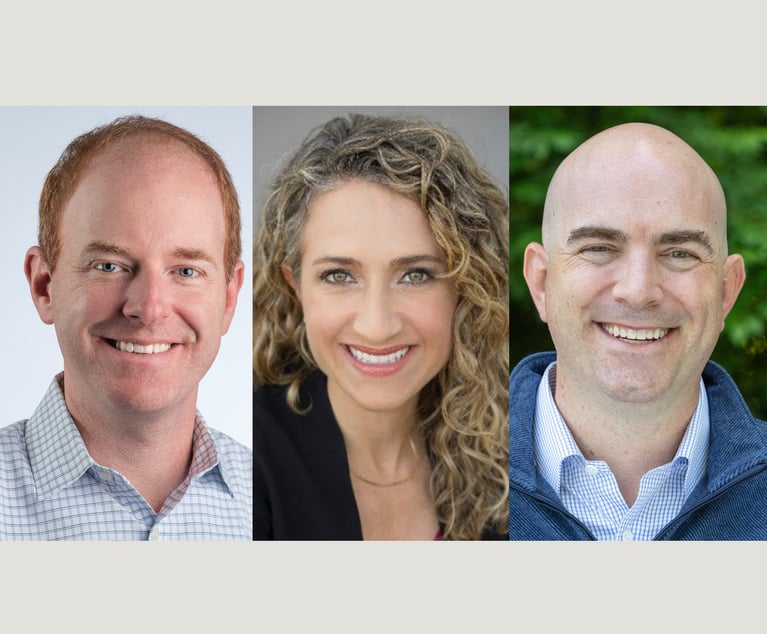The Fight Continues: Apple v. Samsung Heads Back to Court for Third Trial
Apple and Samsung are back for more. Lawyers for the two tech giants gave their opening arguments on Tuesday in San Jose.
May 15, 2018 at 06:19 PM
8 minute read
The original version of this story was published on The Recorder

The seven-year-long patent infringement battle Apple v. Samsung kicked off its third trial Tuesday morning in San Jose, with opening statements from lawyers on both sides of the seemingly never-ending dispute.
This iteration of the legal fight is limited to determining damages only and is scheduled to end Friday.
After U.S. District Judge Lucy H. Koh of the Northern District of California provided instructions to the jury—jury selection went until 5 p.m. Monday—Wilmer Cutler Pickering Hale & Dorr partner William Lee, who represents Apple Inc., kicked off arguments.
Lee, who has figured prominently in Apple's motions and appeals, is picking up the role of lead trial counsel. Morrison & Foerster partner Harold McElhinny, who once played the leading role for Apple, has retired and partner Rachel Krevans, who also represented the Cupertino, California-based company died last year.
Lee showed the jury a series of Samsung phones released before, shortly after and years after the iPhone's debut in 2007.
“Today, when we think of smartphones, we think of devices that look like the iPhone,” Lee said. “But that's why it's critically important for us to step back in time. Do you remember what cellphones looked like in 2006?”
➤➤ Get IP news and commentary straight to your inbox with Skilled in the Art, an email briefing from Law.com. Learn more and sign up here.
Samsung's pre-iPhone devices had keypads and smaller screens, while later models are screen-focused with app icons and no keypad. Lee argued that the iPhone's design is a major part of what made it a top seller, and that Samsung deliberately copied the black screen, rounded corners, bezels and application layout to boost sales.
“It took Apple several years and over $1 billion to develop the iPhone,” Lee told the jury. “Samsung recognized they had a crisis of design and in four months—four months—came up with the infringing phones.”
Apple's team is asking for more than $1 billion for Samsung's infringement on three design patents, the full profit Samsung earned from the sale of infringing phones, and another $5 million for the South Korea-based company's infringement of two utility patents.
While the design patents are the main event, the jury will also award damages for Samsung's infringement of two utility patents related to manipulating documents on a touch screen. The first jury had awarded damages based on those patents and on trade dress for 13 Samsung models, necessitating a recalculation of damages for the utility patent infringement only.
John Quinn, a founding partner of Quinn Emanuel Urquhart & Sullivan who is representing Samsung alongside firm partners William Price and Victoria Maroulis, countered Lee's argument in his opening statements, arguing that Apple should receive the total phone profits.
He said that Samsung should only be required to pay for profits earned due to the part of the phone that infringed Apple patents. Expert Michael Wagner is expected to offer evidence of how much Apple spends on items such as screen glass to help calculate damages.
“Apple's patents aren't applied to the things on the inside of the phone and even some of the [things on the] outside,” Quinn said. He also argued that the phone industry as a whole was moving toward screen-focused phones in 2007, and that the iPhone was not the first or only phone with a prominent screen design.
If Samsung's profit from the infringing phones is calculated by component rather than the product as a whole, Quinn said the company would pay the much lower price of $28,085,061.
On Monday, Apple's team was chastised by Koh for asking potential jury members whether they thought a number near that one was too low, a concern she brought up again on Tuesday morning.
During Quinn's opening statements, Koh asked the jury to leave the room twice. The first request followed an objection from Apple to Quinn's reference to slides showing pre-2010 phones. Shortly after, Koh asked the jury to leave again. She was concerned with Quinn's references to prior verdicts in the case, as she believed she'd prohibited either side from discussing previous rulings.
The original jury in 2012 awarded $1.049 billion for infringement of Apple design and utility patents and for trade dress dilution. The design patents cover a black rectangular front face with rounded corners and a graphical user interface (GUI) featuring a grid of 16 colorful icons. Following a 2013 retrial on damages, the number was revised down to $930 million.
The Federal Circuit threw out $382 million of the verdict that was related to trade dress and Koh entered judgment for $548 million.
But the U.S. Supreme Court upset all that in 2016 by ruling that Apple might not be entitled to all of the profits earned on Samsung's infringing smartphones. The Patent Act awards all profits from sales of any “article of manufacture” that infringes a patented design. The justices ruled that in the case of a multi-component product like a smartphone, the infringing “article of manufacture” could be the entire phone—as Koh and the Federal Circuit had assumed—but it also might be just one or more of its components.
The Supreme Court left it to the Federal Circuit to determine exactly what the infringing “article of manufacture” is on 18 models of Samsung smartphones. The Federal Circuit in turn kicked the question down to Koh, who is putting it to a jury.
Koh will ask jurors to consider four factors in reaching their decision: the scope of the design claimed in Apple's patents; the relative prominence of the design within the product; whether the design is conceptually distinct from the product; and the physical relationship between the patented design and the rest of the product, including whether the designed portion can be physically separated from the product.
The test was originally developed by the Justice Department in its Supreme Court briefing.
Samsung is expected to argue that the article of manufacture is limited to the glass screen that houses each iPhone. The glass is easily separated from the phone and doesn't cost much, Samsung has argued. Apple isn't entitled to any profit from, say, the internet browser, GPS, camera and phone functionality, according to Samsung expert witness Sam Lucente, a former vice president of design at Hewlett-Packard.
As for the GUI, “a single screen depicting 'a grid of 16 colorful icons on a black screen,' as the Supreme Court put it, is not an entire smartphone or even a substantial part of one,” Lucente states in written testimony. “It is one, very specific ornamental design.”
Samsung also wanted to argue that no damages should be awarded for about 1 million of the phones in question because they're cased in white plastic, rather than black. Koh has forbidden that argument on the ground that Samsung didn't raise it in the previous trial or on appeal. “Moreover, in the seven years of this litigation, Samsung has never produced sales data showing the number of white phones that Samsung sold,” Koh ruled last month.
Apple, meanwhile, will argue that the iPhone is “indivisible” from its revolutionary design. Susan Kare, a GUI designer who was part of Apple's Macintosh design team and has since worked for Microsoft and IBM, will testify that the iPhone GUI cannot be separated conceptually from the phone. “Without the graphical user interface one could not operate the product or access any of its other features,” she states in written testimony. It “does not exist apart from, and cannot be separated from, the infringing Samsung phones.”
Koh will let Kare and other Apple experts cite evidence from the first trial of Samsung's deliberate copying of the iPhone design. But she's blocked Apple's argument that the phones should be viewed from the perspective of a “designer of ordinary skill in the art,” saying there's no basis for importing the “person of ordinary skill in the art” to the design context.
This content has been archived. It is available through our partners, LexisNexis® and Bloomberg Law.
To view this content, please continue to their sites.
Not a Lexis Subscriber?
Subscribe Now
Not a Bloomberg Law Subscriber?
Subscribe Now
NOT FOR REPRINT
© 2025 ALM Global, LLC, All Rights Reserved. Request academic re-use from www.copyright.com. All other uses, submit a request to [email protected]. For more information visit Asset & Logo Licensing.
You Might Like
View All
Big Company Insiders See Technology-Related Disputes Teed Up for 2025

Leveling the Playing Field: Insights From Celebrated Women Legal Leaders
4 minute readTrending Stories
- 1MLB's Texas Rangers Search For a New GC and a Broadcasting Deal
- 2Does the Treasury Hack Underscore a Big Problem for the Private Sector?
- 3Gen AI Legal Tech Startup Eve Raises $47 Million Series A Investment
- 4Hicks Johnson Promotes Lori Arakaki and Daniel Scime to Firm Partnership
- 5Buchalter Opens in Chicago With 25 Lawyers, Staff
Who Got The Work
J. Brugh Lower of Gibbons has entered an appearance for industrial equipment supplier Devco Corporation in a pending trademark infringement lawsuit. The suit, accusing the defendant of selling knock-off Graco products, was filed Dec. 18 in New Jersey District Court by Rivkin Radler on behalf of Graco Inc. and Graco Minnesota. The case, assigned to U.S. District Judge Zahid N. Quraishi, is 3:24-cv-11294, Graco Inc. et al v. Devco Corporation.
Who Got The Work
Rebecca Maller-Stein and Kent A. Yalowitz of Arnold & Porter Kaye Scholer have entered their appearances for Hanaco Venture Capital and its executives, Lior Prosor and David Frankel, in a pending securities lawsuit. The action, filed on Dec. 24 in New York Southern District Court by Zell, Aron & Co. on behalf of Goldeneye Advisors, accuses the defendants of negligently and fraudulently managing the plaintiff's $1 million investment. The case, assigned to U.S. District Judge Vernon S. Broderick, is 1:24-cv-09918, Goldeneye Advisors, LLC v. Hanaco Venture Capital, Ltd. et al.
Who Got The Work
Attorneys from A&O Shearman has stepped in as defense counsel for Toronto-Dominion Bank and other defendants in a pending securities class action. The suit, filed Dec. 11 in New York Southern District Court by Bleichmar Fonti & Auld, accuses the defendants of concealing the bank's 'pervasive' deficiencies in regards to its compliance with the Bank Secrecy Act and the quality of its anti-money laundering controls. The case, assigned to U.S. District Judge Arun Subramanian, is 1:24-cv-09445, Gonzalez v. The Toronto-Dominion Bank et al.
Who Got The Work
Crown Castle International, a Pennsylvania company providing shared communications infrastructure, has turned to Luke D. Wolf of Gordon Rees Scully Mansukhani to fend off a pending breach-of-contract lawsuit. The court action, filed Nov. 25 in Michigan Eastern District Court by Hooper Hathaway PC on behalf of The Town Residences LLC, accuses Crown Castle of failing to transfer approximately $30,000 in utility payments from T-Mobile in breach of a roof-top lease and assignment agreement. The case, assigned to U.S. District Judge Susan K. Declercq, is 2:24-cv-13131, The Town Residences LLC v. T-Mobile US, Inc. et al.
Who Got The Work
Wilfred P. Coronato and Daniel M. Schwartz of McCarter & English have stepped in as defense counsel to Electrolux Home Products Inc. in a pending product liability lawsuit. The court action, filed Nov. 26 in New York Eastern District Court by Poulos Lopiccolo PC and Nagel Rice LLP on behalf of David Stern, alleges that the defendant's refrigerators’ drawers and shelving repeatedly break and fall apart within months after purchase. The case, assigned to U.S. District Judge Joan M. Azrack, is 2:24-cv-08204, Stern v. Electrolux Home Products, Inc.
Featured Firms
Law Offices of Gary Martin Hays & Associates, P.C.
(470) 294-1674
Law Offices of Mark E. Salomone
(857) 444-6468
Smith & Hassler
(713) 739-1250








